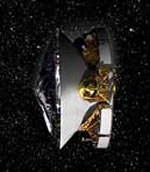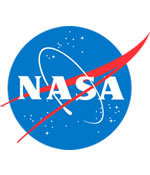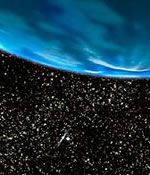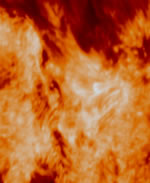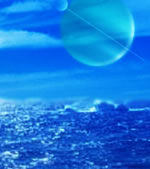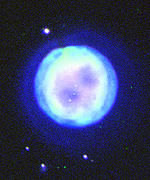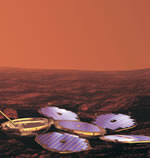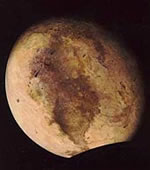
Image credit: NASA
A team of astronomers from MIT reported today that Pluto’s atmosphere is expanding, even as the planet is getting further away from the Sun on its elliptical orbit. The team made their findings by watching the dimming of a star as Pluto passed in front. Astronomers were expecting to find the opposite situation; that its atmosphere would shrink as it gets further from the Sun, but it’s similar to the Earth, where early afternoon is hotter than noon, when the Sun is at its brightest. If all goes well, NASA will launch its New Horizons mission by 2006 to reach Pluto in 2015.
Pluto?s atmosphere is expanding even as it continues on its long orbit away from the sun, a team of astronomers from MIT, Boston University, Williams College, Pomona College, Lowell Observatory and Cornell University report in the July 10 issue of Nature.
The team, led by James Elliot, professor of planetary astronomy at MIT and director of MIT?s Wallace Observatory, made this finding by watching the dimming of a star when Pluto passed in front of it on Aug. 20, 2002. The team carried out observations using eight telescopes at Mauna Kea Observatory, Haleakala, Lick Observatory, Lowell Observatory and Palomar Observatory.
Elliot said the new results seem counterintuitive, because observers assumed Pluto?s atmosphere would begin to collapse as it cooled. In fact, the temperature of Pluto?s mostly nitrogen atmosphere has increased around 1 degree Celsius since it was closest to the sun in 1989.
Elliot attributes the increase to the same lag effect that we experience on Earth?even though the sun is most intense at its highest point at noon, the hottest part of the day is around 3 p.m. Because Pluto’s year is equal to 248 Earth years, 14 years after Pluto’s closest approach to the Sun is like 1:15 p.m. on Earth. At the rate of Pluto?s orbit, it may take another 10 years to cool down and would just be beginning to cool when the NASA New Horizons mission to Pluto, scheduled to be launched in 2006, reaches it in 2015.
Pluto?s predominantly nitrogen atmosphere is in vapor pressure equilibrium with its surface ice, and can therefore undergo large changes in pressure in response to small changes in surface ice temperature. As its icy surface gets colder, it condenses into fresh white frost that reflects more of the sun?s heat and gets colder still. As space dirt and objects collect on its surface, it darkens and absorbs more heat, accelerating the warming effect. Pluto has been darkening since 1954.
?The August 2002 data have allowed us to probe much more deeply into Pluto’s atmosphere and have given us a more accurate picture of the changes that have occurred,” Elliot said.
Pluto?s orbit is much more elliptical than that of the other planets, and its rotational axis is tipped by a large angle relative to its orbit. Both factors could contribute to drastic seasonal changes.
Since 1989, for example, the sun?s position in Pluto?s sky has changed by more than the corresponding change on the Earth that causes the difference between winter and spring. Pluto’s atmospheric temperature varies between around -235 and -170 degrees Celsius, depending on the altitude above the surface.
Pluto has nitrogen ice on its surface that can evaporate into the atmosphere when it gets warmer, causing an increase in surface pressure. If the observed increase in the atmosphere also applies to the surface pressure?which is likely the case?this means that the average surface temperature of the nitrogen ice on Pluto has increased slightly more than 1 degree Celsius over the past 14 years.
STUDYING ATMOSPHERES WITH SHADOWS
Researchers study faraway objects through occultations?eclipse-like events in which a body (Pluto in this case) passes in front of a star, blocking the star?s light from view. By recording the dimming of the starlight over time, astronomers can calculate the density, pressure and temperature of Pluto?s atmosphere.
Observing two or more occultations at different times provides researchers with information about changes in the planet?s atmosphere. The structure and temperature of Pluto?s atmosphere was first determined during an occultation in 1988. Pluto?s brief pass in front of a different star on July 19 led researchers to believe that a drastic atmospheric change was under way, but it was unclear whether the atmosphere was warming or cooling.
The data resulting from this occultation, when Pluto passed in front of a star known as P131.1, led to the current results. ?This is the first time that an occultation has allowed us to probe so deeply into Pluto’s atmosphere with a large telescope, which gives a high spatial resolution of a few kilometers,? Elliot said. He hopes to use this method to study Pluto and the Kuiper Belt objects more frequently in the future.
MISSION TO PLUTO
NASA recently authorized the New Horizons Pluto-Kuiper Belt mission to start building spacecraft and ground systems. The mission will be the first to Pluto and the Kuiper Belt. Richard P. Binzel, professor of earth, atmospheric and planetary sciences (EAPS) at MIT, is co-investigator.
The New Horizons spacecraft is scheduled to launch in January 2006, swing past Jupiter for a gravity boost and scientific studies in 2007, and reach Pluto and Charon moon of Pluto as early as summer 2015. Pluto is the only planet not yet observed at close range. This mission will seek to answer questions about the surfaces, atmospheres, interiors and space environments of the solar system?s outermost planet and its moon.
In the meantime, researchers hope to use SOFIA, a 2.5-meter telescope mounted in an aircraft being built by NASA in collaboration with the German space agency, starting in 2005. SOFIA would be able to be sent to the right location around the globe to best observe occultations, providing high-quality data on a much more frequent basis than is possible using ground-based telescopes alone.
In addition to Elliot, MIT co-authors are recent physics graduate Kelly B. Clancy; graduate students Susan D. Kern and Michael J. Person; recent MIT graduate Colette V. Salyk; and aeronautics and astronautics senior Jing Jing Qu.
The Williams College collaborators included Jay M. Pasachoff, professor of astronomy; Bryce A. Babcock, staff physicist; Steven V. Souza, observatory supervisor; and undergraduate David R. Ticehurst. They used the University of Hawaii’s telescope at the 13,800-foot altitude of the Hawaiian volcano Mauna Kea and a Williams College electronic detector normally part of eclipse expeditions.
Pomona College collaborators are Alper Ates and Ben Penprase. The Boston University collaborator is Amanda Bosh. Lowell Observatory collaborators are Marc Buie, Ted Dunham, Stephen Eikenberry, Cathy Olkin, Brian W. Taylor, and Lawrence Wasserman. Boeing collaborators are Doyle Hall and Lewis Roberts.
The United Kingdom Infrared Telescope collaborator is Sandy K. Leggett. U.S. Naval Observatory collaborators are Stephen E. Levine and Ronald C. Stone. The Cornell collaborator is Dae-Sik Moon. David Osip and Joanna E. Thomas-Osip were at MIT and are now at the Carnegie Observatories. John T. Rayner is at NASA’s Infrared Telescope Facility. David Tholen is at the University of Hawaii.
This work is funded by Research Corp., the Southwest Research Institute, the National Science Foundation and NASA.
Original Source: MIT News Release
